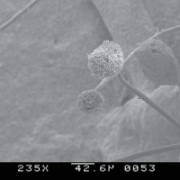Black Mold Traces Found In Courthouse
It’s no secret there’s mold in the Henderson County Courthouse. What hasn’t been clear until now is what kind, how much and how harmful. Now we know: some black mold (known as stachybotrys) and lots of aspergillus mold has been identified; and, yes, both can be harmful.
The Athens Daily Review has obtained a preliminary report containing results from recent testing performed at the courthouse by Southwest Indoor Environmental Group. With black mold receiving so much negative attention in the media of late, it’s natural to assume news of its presence is the most dire revelation contained in the report. Not so, says Dan Guiter of Southwest; it’s the considerable presence of aspergillus that poses the greatest health risk. “In all reality, there are a couple of real areas of concern — primarily the district courtroom [on the second floor] and the basement,” said Guiter.
According to lab results, there are high concentrations of aspergillus in both locations, as well as some black mold in the basement. Even so, Guiter believes the courthouse is safe to work in, particularly since employees in the high-concern areas have been relocated. According to information provided by the Centers for Disease Control, aspergillus mold is a natural allergen normally considered harmless. Stachybotrys, or black mold, is a heavy green-black mold which requires at least 92 percent moisture to thrive. Experts are still debating its potential health threat, which may range from allergy-like symptoms to headaches, skin rashes and neurological problems.The courthouse testing in recent weeks revealed the presence of black mold in three air samples: two from a record room in the basement and a third in the data processing office on the third floor.
The black mold was found in six of the surface tests: trace amounts on the north wall of the district courtroom, in the district clerk’s records room and in the HVAC system upstairs; and larger amounts on a random book chosen on the second floor, on a sample of Sheetrock in the basement and in ceiling tiles in the District Clerk’s Records office, which is also in the basement. Aspergillus was found in many of the surface samples as well as the airborne samples. High airborne concentrations of the mold were found in the evidence room on the second floor, in a record room in the basement, in the law library on the second floor, in the basement office of Pct. 6 JP Milton Adams and in the district attorney’s office on the third floor, as well as other areas.
There are more lab results coming, said Guiter, and the preliminary report should be used only as a guideline, not as the determining factor in what the county should do about the mold problem. In the next week, Guiter and his crew will put together a complete analysis of the data, including hard numbers and specific information about what samples were taken from what areas. Also pending are the results of an engineering report analyzing the problem.
When questioned by Athens Review reporters Wednesday, County Judge Aubrey Jones and county commissioners said they had not seen the preliminary results. After being provided a copy of the data, Jones said, “Those results are very, very preliminary. This is not the final deal at all.”
Pct. 2 Commissioner Wade McKinney said he is not surprised by the results. “If [the high concentrations] are in the basement, I’m not surprised,” said McKinney. This is the first time he has heard about lab results indicating the presence of black mold, he added. Guiter said he believes the majority of the health problems being attributed to the working environment by employees in the courthouse are not being caused by the black mold, but by the aspergillus. There are over 150 kinds of aspergillus, and some of them can cause serious respiratory problems when a person is continuously exposed, he said.
“Aspergillus is the predominant genera of mold in the courthouse,” emphasized Guiter. His company has sent samples from the courthouse to another lab to determine if any of the aspergillus mold should be considered dangerous. Those who are vulnerable to respiratory problems could really have complications after several years of exposure to aspergillus mold, Guiter maintains. “We know the level is high enough that, if you have allergies to start with, it is certainly high enough to cause those things to flare up,” he said.
McKinney agrees, saying: “I’m sure it would cause problems for those who are sensitive to it.” Asked about the relocation of some employees off the courthouse grounds because of persistent health problems, Jones acknowledged that Pct. 6 Justice of the Peace Milton Adams and his assistant and those who work for Judge Jack Holland’s court have been moved because of the presence of mold and high levels of humidity. He said he did not believe those relocations will be long-term.
“Other (employees) have been talking about it and asking whether they should be moved, but I don’t see any such thing happening at this time,” Jones said, though he added that could change, depending on final results provided by Southwest Indoor Environmental. Even if it is determined the aspergillus is definitely the primary cause of the alleged health problems, said Guiter, stachybotrys is still a concern and any location where it has been found will have to be thoroughly cleaned. For example, he noted, the Sheetrock in the basement where the black mold was discovered will have to be replaced and ceiling tiles in the basement must also be removed.
Guiter also insists the humidity levels in the building are just as responsible for any health problems as the mold. When the courthouse was tested, humidity levels were measured in the second floor courtroom for three straight days. In that time, levels were constantly around 90 percent. Humidity is normally about 45 percent, Guiter said, who noted anything over 60 percent is uncomfortable. “The air is so heavy that it fatigues you and it gives you a headache,” he said. Those humidity levels are responsible for the growth of mold in the courthouse, he claims. People who walk in and out of a building carry mold spores on their shoes. Some of those are aspergillus and many are stachybotrys. But most buildings do not contain the kind of humidity required to give those spores a healthy growth environment. Specifically, stachybotrys requires almost 100 percent humidity to grow, said Guiter. The samples that were found in the courthouse were mainly on ceiling tiles and in sections of wall where either leaks or condensation caused by the humidity had left standing water. Fortunately, that also makes it easy for environmental experts to find.
So what caused the humidity levels? “That is solely, solely an (air conditioning system) problem,” he said. The heating ventilation and air conditioning (HVAC) system is over 50 years old and many of the components are worn beyond repair, and leaks within the system are running the humidity levels up. It will take some effort to remove the mold, said Guiter, but the task is not anywhere near impossible.
The county judge agrees. Based on his previous conversations with Guiter, Jones said, “I think we’re in a lot better shape than what people are saying. We’ve got a couple of small problems. We’ve got a lot of aspergillus, but our big problem is humidity. We need to get rid of the high levels of humidity and balance the air quality.” As for himself, Jones said his health is fine, and he feels “safe working in the courthouse.”
Guiter is expected to present a final analysis of the situation to the commissioners court next week. Among his recommendations will likely be the replacement of those areas where black mold has been found, thorough filtering of the building’s air and replacement of the HVAC system. Already installed are air-scrubbing filters in part of the basement, which remove mold spores from the air. In addition, Guiter plans to bring in a large air-scrubbing machine, which basically performs the same function as the filter on a larger scale, and systematically go through the courthouse removing spores.
McKinney said he is ready to do whatever is necessary to get the problem resolved, and he thinks the other three commissioners feel the same way. “We don’t want anyone to get sick because of the building,” said McKinney. “I have a lot of faith in what (Guiter) is doing and in his recommendations.”
Staff writer Elise Mullinix contributed to this story.


 Image by
Image by 



